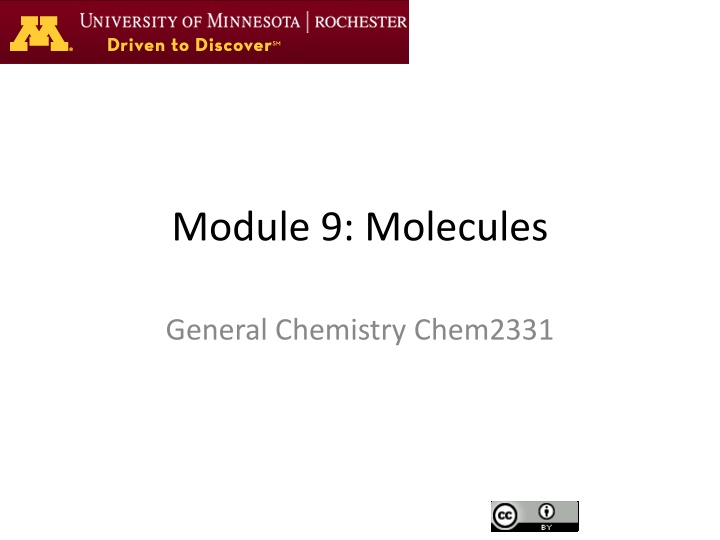
Understanding Molecular Shapes in Chemistry
Explore the concept of molecular shapes through VSEPR theory, focusing on various geometries and the impact of lone pairs on molecule structure. Practice drawing Lewis structures and identifying central atoms to understand molecular arrangements. Delve into examples like NH3, SO3, and CH4 to grasp the concept better.
Download Presentation

Please find below an Image/Link to download the presentation.
The content on the website is provided AS IS for your information and personal use only. It may not be sold, licensed, or shared on other websites without obtaining consent from the author. If you encounter any issues during the download, it is possible that the publisher has removed the file from their server.
You are allowed to download the files provided on this website for personal or commercial use, subject to the condition that they are used lawfully. All files are the property of their respective owners.
The content on the website is provided AS IS for your information and personal use only. It may not be sold, licensed, or shared on other websites without obtaining consent from the author.
E N D
Presentation Transcript
Module 9: Molecules General Chemistry Chem2331
Module 9 Outline Module 9 Session 1 VSEPR model 1. Shapes of molecules: perfect geometries AX2, AX3, AX4, AX5 and AX6 2. Shapes of molecules with lone pairs: AXnEm 3. Predicting angles: effect of lone pairs and double bonds 4. Molecular dipole Chem 2331: General Chemistry 2
Molecular shape What s the shape of molecules? Each group of valence electrons around a central atom is located as far away as possible from the others in order to maximize repulsions. These repulsions maximize the space that each object attached to the central atom occupies. VSEPR: Valence Shell Electron Pair Repulsion Theory Central Atom Surrounding Atoms Chem 2331: General Chemistry 3
Molecular shape Activity: Draw the Lewis structures for BeF2, SO3, CH4. Draw the angle between the central atom and the bonded atoms. Identify the central atom. Usually the least electronegative Draw the Lewis structure displaying the surrounding atoms separated from each other to minimize the repulsion What is the structure of the molecule in the space? Think about NH3 (remember that it has a lone pair). Chem 2331: General Chemistry 4
VSEPR: Valence Shell Electron Pair Repulsion Theory linear tetrahedral trigonal planar 109.5 is the angle of a tetrahedron Examples: Examples: Examples: SO3, BF3, NO3 , CO32 CS2, HCN, BeF2 CH4, SiCl4, SO42-, ClO4- Chem 2331: General Chemistry 5
VSEPR: Valence Shell Electron Pair Repulsion Theory Less important structures that you may need for homework (not for the test) trigonal bipyramidal octahedral SF6 PF5 Chem 2331: General Chemistry 6
VSEPR: Valence Shell Electron Pair Repulsion Theory Atoms and lone pairs in the space A - central atom A - central atom X -surrounding atom X -surrounding atom E -nonbonding valence electron-group E -nonbonding valence electron-group AXmEn The textbook will cover more complicated structures that are not relevant in Health Sciences integers The lone pairs will behave like a bulky surrounding atom. e.g. SO2 Chem 2331: General Chemistry 7
VSEPR: Valence Shell Electron Pair Repulsion Theory Examples: SO2, O3, PbCl2, SnBr2 What geometry would you obtain for AX1E2? Chem 2331: General Chemistry 8
VSEPR: Valence Shell Electron Pair Repulsion Theory Examples: CH4, SiCl4, SO42-, ClO4- NH3 H2O PF3 OF2 ClO3 SCl2 H3O+ Chem 2331: General Chemistry 9
VSEPR: Valence Shell Electron Pair Repulsion Theory Less important structures that you may need for homework (not for the test) PF5 AsF5 SOF4 SF4 XeO2F2 IF4+ IO2F2- XeF2 I3- IF2- ClF3 BrF3 Chem 2331: General Chemistry 10
VSEPR: Valence Shell Electron Pair Repulsion Theory Less important structures that you may need for homework (not for the test) SF6 IOF5 BrF5 TeF5- XeOF4 XeF4 ICl4- Chem 2331: General Chemistry 11
VSEPR: Valence Shell Electron Pair Repulsion Theory Factors Affecting Actual Bond Angles Bond angles are consistent with theoretical angles when the atoms attached to the central atom are the same and when all electrons are bonding electrons of the same order. 120o 122o Effect of Double Bonds H H 120o C O 116o C O ideal H H greater electron density real Effect of Nonbonding (Lone) Pairs Both lone pairs and multiple bonds will use more space than regular bonds Lone pairs repel bonding pairs more strongly than bonding pairs repel each other. Sn Cl Cl 95o Chem 2331: General Chemistry 12
Molecular Dipole Polarity of a molecule The boiling point of NH3is 33.34 C while the boiling point of BF3 is much lower -100.3 C WHY? The dipoles reinforce each other, so the overall molecule is definitely polar. ENN = 3.0 ENH = 2.1 N N N HH H HH HH H H molecular dipole bond dipoles F BF3 is non-polar because the dipole of the bonds cancel each other. B F F (EN 4.0) All bonds in the same plane F B (EN 2.0) 1200 Chem 2331: General Chemistry 13
Molecular dipole Which of the following molecules is the most polar molecule? Br Cl F Cl Br Br Cl F Br Cl Te Te Te Te Te Br Cl F Br Cl Br Cl F Cl Br a) b) c) d) e) Chem 2331: General Chemistry 14





















